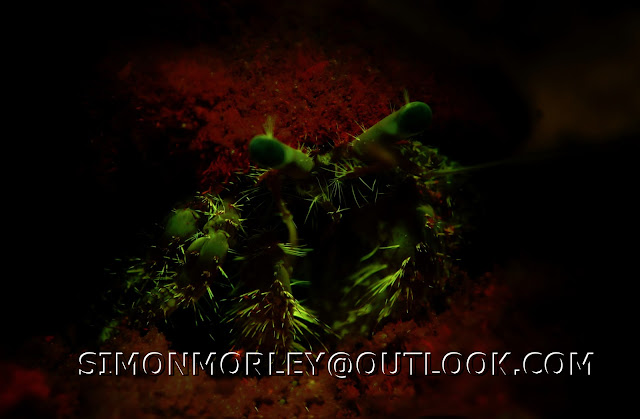It wasn't till the end of the dive that we found a small section of the main wall that had everything. Overhangs, swimthroughs, loads of sponges and corals and plenty of marine life.
Unfortunately as we we were skirting close to the fringes of deco we didn't get any shots but we made a note of where it was for a return visit through the week. We did get a couple of turltes giving us a fly by on the way back to shore though, so not a bad dive.
 |
| Turtle are 3 o'clock! Dive! Dive! |
 |
| Darkness fell. *Thunk!* |
Not everything "pops" under blue light, so it's not something you would do the entire dive on and when you have the yellow filter visor on, you lose any available ambient light there may be. It's like night diving with sun glasses on. But when you light up the right thing at the right time, the effects can be very pleasing.
Things that you wouldn't normally see suddenly start shining like a beacon. Bristleworms for example are everywhere, in every nook and cranny, the place is littered with them. But switch back to white light and you would never know they were there and never see them.
 |
| Juvenile crab on brain coral. I would never have spotted this under white light. |
Also there are some critters that absolutely hate blue light and go nuts trying to get away from it. For me, the amount of times it would get used just doesn't justify the outlay. And I personally I get more of challenge shooting with white light, but each to their own. Should you get an opportunity to try out blue light on a night dive then I can highly recommend it for the experience, but for photography, not so much.
 |
 |
| "I was born this way, what's your excuse?" |
On the plus side Jill did find a yellow stingray which was parked right underneath me whilst i was taking a shot of something else. However, unlike 633068 who visited us recently, I actually saw what she was pointing at and took the shot. :-P
 |
| "Where's 633068 when I want a picture taken now?" |
 |
| "You can trust me completely, I'm totally transparent......." |
 |
| Small slug on a small sea fan |
As an added bonus there was also a juvenile bristleworm close by as well so that had to get photographed, it would be rude not to...........
 |
| "Don't forget about me!" |
And for a final parting shot, there was this tiny chap hiding under a little piece of sea grass.




No comments:
Post a Comment